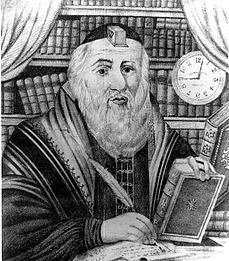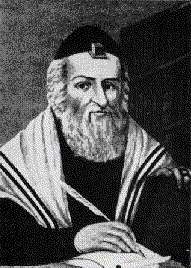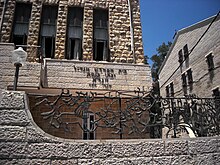This is an old revision of this page, as edited by 93.173.55.85 (talk) at 11:56, 23 May 2014 (→Methods of study). The present address (URL) is a permanent link to this revision, which may differ significantly from the current revision.
Revision as of 11:56, 23 May 2014 by 93.173.55.85 (talk) (→Methods of study)(diff) ← Previous revision | Latest revision (diff) | Newer revision → (diff)| This article has multiple issues. Please help improve it or discuss these issues on the talk page. (Learn how and when to remove these messages)
No issues specified. Please specify issues, or remove this template. (Learn how and when to remove this message) |
| RabbiElijah ben Shlomo Zalman Kremer | |
|---|---|
 Vilna Gaon Vilna Gaon | |
| Title | Vilna Gaon Elijah of Vilna Gra |
| Personal life | |
| Born | April 23, 1720 Vilnius, Polish-Lithuanian Commonwealth |
| Died | October 9, 1797 (aged 77) Vilnius, Russian Empire |
| Religious life | |
| Religion | Judaism |
Elijah ben Shlomo Zalman Kremer, (Template:Lang-he) known as the Vilna Gaon (Template:Lang-yi) or Elijah of Vilna, or by his Hebrew acronym Gra ("Gaon Rabbenu Eliyahu") or Elijah Ben Solomon, (Vilnius April 23, 1720 – Vilnius October 9, 1797), was a Talmudist, halachist, kabbalist, and the foremost leader of mitnagdic (non-hasidic) Jewry of the past few centuries. He is commonly referred to in Hebrew as ha-Gaon he-Chasid mi-Vilna, "the saintly genius from Vilnius."
Through his annotations and emendations of Talmudic and other texts he became one of the most familiar and influential names in rabbinic study since the Middle Ages, counted by many among the sages known as the Acharonim, and ranked by some with the even more revered Rishonim of the Middle Ages. Large groups of people, including many yeshivas, uphold the set of Jewish customs and rites (minhag), the "minhag ha-Gra," which is named for him, and which is also considered by many to be the prevailing Ashkenazi minhag in Jerusalem.
Born in Vilnius, capital city of Grand Duchy of Lithuania, the Gaon displayed extraordinary talent while still a child. By the time he was twenty years old, rabbis were submitting their most difficult halakhic problems to him for legal rulings. He was a prolific author, writing such works as glosses on the Babylonian Talmud and Shulchan Aruch known as Bi'urei ha-Gra ("Elaborations by the Gra"), a running commentary on the Mishnah (Shenoth Eliyahu ("The Years of Elijah"), and insights on the Pentateuch entitled Adereth Eliyahu ("The Splendor of Elijah"; published by his son). Various Kabbalistic works have commentaries in his name, and commentaries on the Proverbs and other books of the Tanakh were written later on in his life. None of his manuscripts were published in his lifetime.
When Hasidic Judaism became influential in his native town, the Vilna Gaon joined the "opposers" or Mitnagdim, rabbis and heads of the Polish communities, to curb Hasidic influence. In 1777, one of the first excommunications against the nascent Hasidic movement was launched in Vilna.
He encouraged his students to study secular sciences, and even translated geometry books to Yiddish and Hebrew, chief among them Sefer HaEuclid.
An example of the Gaon's genius can be seen in his commentary Adereth Eliyahu (on Genesis 1:4). The medieval Spanish Jewish community leader Ramban asks (though the Gaon doesn't mention Ramban's question, his grandson made the connection to the Ramban's question in his commentary on his grandfather's commentary) "Is light the absence of darkness as Thomas Aquinas and others derived from the Prophets?".
And God divided the light from the darkness: "I must infer from the verse that darkness is a separate creation from light and unrelated, rather than the physical absence of light"... "is different from 'the darkness' mentioned in the first verse."
Methods of study
The Gaon applied to the Talmud and rabbinic literature proper philological methods. He made an attempt toward a critical examination of the text; thus, very often with a single reference to a parallel xcmghxfi gxfui hbvxcj ghdifhg7777777777777777777777777777777777777777777777777777777777777777777777777777777777777777777777777777777777777777777777777777777777777777777777777777777777777777777777777777777777777777777777777777777777777777777777777777777777777777777777777777777777777777777777777777777777777777777777777777777777777777777777777777777777777777777777777777777777777777777777777777777777777777777777777777777777777777777777777777777777777777777777777777777777777777777777777777777777777777777777777777777777777777777777777777777777777777777777777777777777777777777777777777777777777777777777777777777777777777777777777777777777777777777777777777777777777777777777777777777777777777777777777777777777777777777777777777777777777777777777777777777777777777777777777777777777777777777777777777777777777777777777777777777777777777777777777777777777777777777777777777777777777777777777777777777777777777777777777777777777777777777777777777777777777777777777777777777777777777777777777777777777777777777777777777777777777777777777777777777777777777777777777777777777777777777777777777777777777777777777777777777777777777777777777777777777777777777777777777777777777777777777777777777777777777777777777777777777777777777777777777777777777777777777777777777777777777777777777777777777777777777777777777777777777777777777777777777777777777777777777777777777777777777777777777777777777777777777777777777777777777777777777777777777777777777777777777777777777777777777777777777777777777777777777777777777777777777777777777777777777777777777777777777777777777777777777777777777777777777777777777777777777777777777777777777777777777777777777777777777777777777777777777777777777777777777777777777777777777777777777777777777777777777777777777777777777777777777777777777777777777777777777777777777777777777777777777777777777777777777777777777777777777777777777777777777777777777777777777777777777777777777777777777777777777777777777777777777777777777777777777777777777777777777777777777777777777777777777777777777777777777777777777777777777777777777777777777777777777777777777777777777777777777777777777777777777777777777777777777777777777777777777777777777777777777777777777777777777777777777777777777777777777777777777777777777777777777777777777777777777777777777777777777777777777777777777777777777777777777777777777777777777777777777777777777777777777777777777777777777777777777777777777777777777777777777777777777777777777777777777777777777777777777777777777777777777777777777777777777777777777777777777777777777777777777777777777777777777777777777777777777777777777777777777777777777777777777777777777777777777777777777777777777777777777777777777777777777777777777777777777777777777777777777777777777777777777777777777777777777777777777777777777777777777777777777777777777777777777777777777777777777777777777777777777777777777777777777777777777777777777777777777777777777777777777777777777777777777777777777777777777777777777777777777777777777777777777777777777777777777777777777777777777777777777777777777777777777777777777777777777777777777777777777777777777777777777777777777777777777777777777777777777777777777777777777777777777777777777777777777777777777777777777777777777777777777777777777777777777777777777777777777777777777777777777777777777777777777777777777777777777777777777777777777777777777777777777777777777777777777777777777777777777777777777777777777777777777777777777777777777777777777777777777777777777777777777777777777777777777777777777777777777777776e7777777777777777777777777777777777777777777777777777777777777777777777777777777777777777777777777777777777777777777777777777777777777777777777777777777777777777777777777777777777777777777777777777777777777777777777777777777777777777777777777777777777777777777777777777777777777777777777777777777777777777777777777777777777777777777777777777777777777777777777777777777777777777777777777777777777777777777777777777777777777777777777777777777777777777777777777777777777777777777777777777777777777777777777777777777777777777777777777777777777777777777777777777777777777777777777777777777777777777777777777777777777777777777777777777777777777777777777777777777777777777777777777777777777777777777777777777777777777777777777777777777777777777777777777777777777777777777777777777777777777777777777777777777777777777777777777777777777777777777777777777777777777777777777777777777777777777777777777777777777777777777777777777777777777777777777777777777777777777777777777777777777777777777777777777777777777777777777777777777777777777777777777777777777 77777777777777777777777777777777777777777777777777777777777777777777777777777777777777777777777777777777777777777777777777777777777777777777777777777777777777777777777777777777777777777777777777777777777777777777777777777777777777777777777777777777777777777777777777777777777777777777
Antagonism to Hasidism

When Hasidic Judaism became influential in Vilna, the Vilna Gaon, joining the rabbis and heads of the Polish communities, took steps to check the Hasidic influence. In 1777 one of the first excommunications by the Mitnagdim was launched in Vilna against the Hasidim, while a letter was also addressed to all of the large communities, exhorting them to deal with the Hasidim following the example of Vilna, and to watch them until they had recanted. The letter was acted upon by several communities; and in Brody, during the trade fair, the cherem (ban of excommunication) was pronounced against the Hasidim.
In 1781, when the Hasidim renewed their proselytizing work under the leadership of their Rabbi Shneur Zalman of Liadi (the "Ba'al Ha'tanya"), the Gaon excommunicated them again, declaring them to be heretics with whom no pious Jew might intermarry. However, the excommunications did not stop the tide of Hasidism.
Other work
Except for the conflict with the Hasidim, the Vilna Gaon almost never took part in public affairs and, so far as is known, did not preside over any school in Vilna. He was satisfied with lecturing in his bet ha-midrash to a few chosen pupils, whom he initiated into his methods. He taught them Hebrew grammar, Hebrew Bible, and Mishna, subjects which were largely neglected by the Talmudists of that time. He was especially anxious to introduce them to the study of midrash literature, and the Minor Treatises of the Talmud, which were very little known by the scholars of his time.
He laid special stress on the study of the Jerusalem Talmud, which had been almost entirely neglected for centuries. As the Mishna in Tractate Peah (1:1) states: "The study of Torah is equal to all of the mitzvos", and being convinced that the study of the Torah is the very life of Judaism, and that this study must be conducted in a scientific and not in a merely scholastic manner, the Gaon encouraged his chief pupil, Rabbi Chaim of Volozhin, to found a yeshiva (rabbinic academy) in which rabbinic literature should be taught. Rabbi Chaim Volozhin opened the Volozhin yeshiva in 1803, a few years after the Gaon's death, and revolutionized Torah study, with resulting impact on all of Orthodox Jewry.
Asceticism

The Vilna Gaon led an ascetic life. He interpreted literally the words of the Jewish sages, that the Torah can be acquired only by abandoning all pleasures and by cheerfully accepting suffering; and as he lived up to this principle, he was revered by his countrymen as a saint, being called by some of his contemporaries "the Hasid". While he was an opponent to the Hasidic movement, the term itself means "pious person" and is used here without reference to the movement.
The Gaon once started on a trip to the Land of Israel, but for unknown reasons did not get beyond Germany. (In the early nineteenth century, three groups of his students, known as Perushim, did manage the trip, settling mostly in Tzfat and Jerusalem). While at Königsberg he wrote to his family a letter which was published under the title Alim li-Terufah, Minsk, 1836.
Works
The Vilna Gaon was a copious annotator; there is hardly an ancient Hebrew book of any importance to which he did not provide marginal glosses and notes, or write a brief commentary, which were mostly dictated to his pupils. (Many maintain that it was his disciples who recorded his comments, if not his editorial notes.) However, nothing of his was published in his lifetime. The "Gra" was very precise in the wording of his commentaries, because he maintained that he was obligated by Torah Law that only the "Torah shebichtav" (the written law) is permitted to be written down - the rest of "Torah sheb'al peh" (oral law) cannot be, unless circumstances require. (This further supports the view that it was his disciples who wrote his comments.) So the Vilna Gaon abided by this view of law by reducing his extensive explanations that are largely inscrutable to any but advanced talmudists. Glosses on the Babylonian Talmud and Shulchan Aruch are known as Bi'urei ha-Gra ("Elaborations by the Gra"). His running commentary on the Mishnah is titled Shenoth Eliyahu ("The Years of Elijah"). Various Kabbalistic works have commentaries in his name. His insights on the Pentateuch are titled Adereth Eliyahu ("The Splendor of Elijah"). Commentaries on the Proverbs and other books of the Tanakh were written later on in his life.
He also wrote on mathematics, being well versed in the works of Euclid and encouraging his pupil Rabbi Baruch of Shklov to translate the great mathematician's works into Hebrew. A mathematical work titled Ayil Meshulash ("A Ram in Three Parts", a reference to Abraham's "Covenant Between the Parts" in Genesis 15:9) is generally attributed to him.
Influence


He was one of the most influential rabbinic authorities since the Middle Ages, and—although he is properly an Acharon—he is held by many authorities after him as belonging to the Rishonim (rabbinic authorities of the Middle Ages).
His main student Rabbi Chaim Volozhin, founded the first yeshiva in his home town of Volozhin, Belarus. The results of this move is claimed to have revolutionized Torah study, by departing from the centuries of 'informal' study. Youth and scholars would congregate in local synagogues and study freely, although it was customary to migrate to towns possessing great scholars as the local rabbi. The Volozhin Yeshivah created a formal structure of study, by providing qualified faculty, meals, and accommodation. The results of this process are currently the norm in Orthodox Jewry.
In accordance with the Vilna Gaon's wishes, three groups of his disciples and their families, numbering over 500, made aliyah to the Land of Israel between 1808 and 1812, a movement documented in Arie Morgenstern's book, Hastening Redemption. This immigration is considered by some, to be the beginning of the modern Jewish settlement in Palestine, although the Hasisdic immigration was already active in the 1780s (by leaders themselves, as the elderly Menachem Mendel of Vitebsk, a second generation Hasisdic leader). These 'disciples of the Gra', were called Perushim, who were ascetics or "separators", because, as groups, they separated themselves from worldly pleasures to study the Torah. They originally settled in Safed because the Muslim authorities in Jerusalem prevented settlement by Ashkenazi Jews in that city, but after numerous devastating calamities there, including plague and earthquake, most moved to Jerusalem. Their arrival in Jerusalem, which for over 100 years had been mainly Sephardi, revived the presence of Ashkenazi Jewry in Jerusalem, and resulted in a dominance of the 'customs of the Gra', as above
The aliyah of the Perushim has had a widespread and ongoing effect on the Jews in Palestine. They have spread the teachings of the Vilna Gaon, which have had a considerable influence on Jewish thought and religious practice amongst the Ashkenazi community. For example, the widespread custom in Israel not to wear tefillin during Chol Hamoed and the accepted time for the onset of Shabbat in Jerusalem and other cities can be traced to the custom of the Vilna Gaon. They also set up several Kollels, founded the Jerusalem neighborhood of Mea Shearim, and were instrumental in rebuilding the Yehudah HeChassid Synagogue (also known as the Hurba Synagogue, or “The Ruins”), which had lain in ruins for 140 years. The teachings of the Vilna Gaon have strongly influenced the Litvaks in Israel. A prominent Litvak, Rabbi Elazar Shach, helped in the formation of both the Degel HaTorah Party and influential newspaper, as well as the Shas Party.
Somewhat ironically, viewed from a traditional light, the leaders of the Haskalah movement used the study methods of the Vilna Gaon to gain adherents to their movement. Maskilim valued his emphasis on peshat over pilpul, his engagement with and mastery of Hebrew grammar and Bible and his interest in textual criticism of rabbinic texts.
There is a statue of the Vilna Gaon and a street named after him in Vilnius, the place of both his birth and his death. His brother Avraham authored the revered work, "Maalos Hatorah". His son Abraham was also a scholar of note.
Death
After his death in 1797, aged 77, he was buried in the Šnipiškės cemetery in Vilnius, now in Žirmūnai elderate. The cemetery was closed by the Tsarist Russian authorities in 1831 and partly built over.
In the 1950s, Soviet authorities planned to build a stadium and concert hall on the site. They allowed the remains of the Vilna Gaon to be removed and re-interred at the new cemetery.
See also
References
- Recently he has been given the surname Kremer. However neither the Vilna Gaon nor his descendants apparently used this surname, which means shopkeeper. It was possibly mistakenly derived from a nickname of his ancestor Rabbi Moshe Kremer.
- Yaniv, Samuel (Rabbi) (April 17, 2010). "The Vilna Gaon and his Vision of Redemption". Bar Ilan University. Retrieved May 19, 2012.
- The Threefold step of Academia Europeana: a case of Universitas Vilnensis. 2009, p.24
- http://www.mysefer.com/product.asp?cookiecheck=yes&P_ID=421&strPageHistory=related>.
- "Jews protest to Lithuania over ancient cemetery". Reuters. August 22, 2007. Retrieved 2007-08-22.
Sources
- Etkes, Immanuel, et al. The Gaon of Vilna: the man and his image (University of California Press, 2002) ISBN 0-520-22394-2
- "The Gaon of Vilna and the Haskalah movement," by Emanuel Etkes, reprinted in Dan, Joseph (ed.). Studies in Jewish thought (Praeger, NY, 1989) ISBN 0-275-93038-6
- "The mystical experiences of the Gaon of Vilna," in Jacobs, Louis (ed.). Jewish mystical testimonies (Schocken Books, NY, 1977) ISBN 0-8052-3641-4
- Landau, Betzalel and Rosenblum, Yonason. The Vilna Gaon: the life and teachings of Rabbi Eliyahu, the Gaon of Vilna (Mesorah Pub., Ltd., 1994) ISBN 0-89906-441-8
- Shulman, Yaacov Dovid. The Vilna Gaon: The story of Rabbi Eliyahu Kramer ( C.I.S. Publishers, 1994) ISBN 1-56062-278-4
- Ackerman, C.D. (trans.) Even Sheleimah: the Vilna Gaon looks at life (Targum Press, 1994) ISBN 0-944070-96-5
- Schapiro, Moshe. Journey of the Soul: The Vilna Gaon on Yonah/Johan: an allegorical commentary adapted from the Vilna Gaon's Aderes Eliyahu (Mesorah Pub., Ltd., 1997). ISBN 1-57819-161-0
- Freedman, Chaim. Eliyahu's Branches: The Descendants of the Vilna Gaon (Of Blessed and Saintly Memory) and His Family (Avotaynu, 1997) ISBN 1-886223-06-8
- Rosenstein, Neil. The Gaon of Vilna and his Cousinhood (Center for Jewish Genealogy, 1997) ISBN 0-9610578-5-8
External links
- A Precious Legacy Works of the Vilner Gaon Eliyahu b. Zalman
- Biography from the Vilna Gaon Jewish State Museum
- Biography (University of Calgary)
- Biography by Eliezer C. Abrahamson
- Article on burial location
- Family tree
- Vilna Gaon Museum in Lithuania
- Biggest collection of Vilna Gaon links and initiative of global portal dedicated to Vilna Gaon
- The Vilna Gaon's Monumental Torah Edifice Adapted excerpt from the 3 volume work by Rabbi Dov Eliach: HaGaon
- Online English translation of the Gaon's work Kol HaTor, Voice of the Turtledove, written down by his student Rabbi Hillel MiShklov.
- "City of Luz": Torah, Kabbalah and Science - Orthodox Mysticism centered around the teachings of the Gaon of Vilna.
- Chisholm, Hugh, ed. (1911). "Elijah Wilna" . Encyclopædia Britannica (11th ed.). Cambridge University Press.
| Commentators on the Jerusalem Talmud | |
|---|---|
| 16th century | |
| 17th century | |
| 18th century | |
| 19th century | |
| 20th century | |
| Lost commentaries | |
| Unpublished commentaries | |